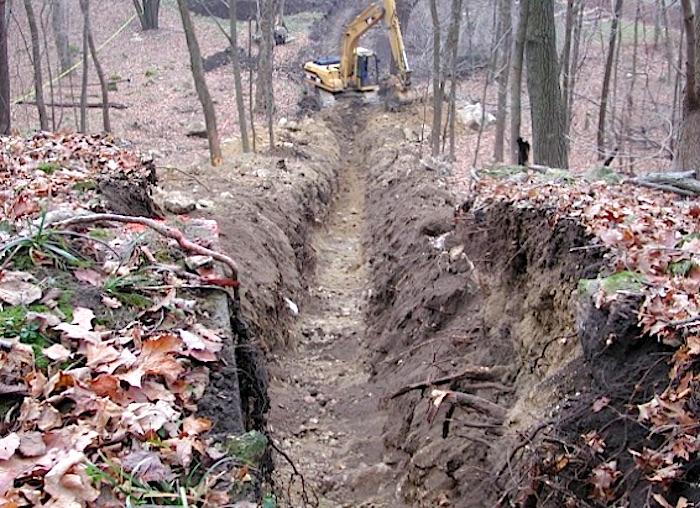
Effigy Mounds National Monument is moving past a long period of archaeological indifference/Marching Bear Mounds, NPS
A breakdown in the system, from the management team in place at Effigy Mounds National Monument to the National Park Service's Midwest Regional Office, led to a decade of mismanagement and desecration of Native American sites the monument was created to protect, stated a Park Service report analyzing the long-running incidents that was released Thursday.
"Looking back, everyone is astonished that the incidents at Effigy Mounds National Monument could have happened over the course of so many years," reads a section of the 50-page report, Effigy Mounds National Monument After Action Review.
In 2014, a voluminous report into management actions from 1999-2010 at the national monument, which is located in Iowa, found that ancestral burial grounds and ceremonial mounds considered sacred by a dozen Native American tribes were desecrated by Park Service managers who "clearly knew what they were doing was against the law" during a decade-long $3.4 million campaign of building boardwalks and trails "throughout the more than 200 American Indian sacred mounds" without conducting the required impact analysis.
The monument's superintendent at the time was ultimately responsible for the work, and was transferred to a position in the regional office not long after the desecration came to light. In 2014 she was fired. The monument's maintenance chief who was its de facto cultural resources compliance officer also is no longer with the National Park Service.
The Special Agent's investigation, built on interviews with monument and regional office staff, memorandums, personnel documents, and budget documents, provided a paper trail leading to both the superintendent and her maintenance chief. That trail indicated that park staff failed to conduct the required archaeological assessments and consultations with state and tribal officials before proceeding with the projects. In some cases, the documents show, compliance with Section 106 of the National Historic Preservation Act was done after the fact.
In one interview conducted by the investigator, the associate regional director for cultural resources in the Park Service's Midwest Region Office said that, "We've tried to understand how a park could behave so badly...Wherever they had a chance to screw up, they did." The official, whose name was redacted from the document, added that the various projects "destroyed" the park and that it would take decades to repair the actual damage as well as the Park Service's reputation.
The report released Thursday raised questions of how the park staff could have ignored the compliance required by the National Historic Preservation Act Section 106, as well that under the Archaeological Resources Protection Act and the Native American Graves Protection and Repatriation Act.
"Inevitably two questions come to mind: Are similar incidents happening in another park unit? How do we make sure these incidents never happen again? These incidents were perpetrated by individuals and their guilt falls under the legal arena. Pertinent to this report is determining how they were able to get away with it for so long," the report questioned.
The report answered some of those questions. In particular, it noted that the superintendent in charge likely shouldn't have been given the position.
"The monument superintendent had a mentor superintendent before becoming the superintendent at Effigy Mounds National Monument. The mentor superintendent reported 'no critical thinking skills' yet the mentee was later assigned as superintendent of the monument," the report said.
Additionally, the projects' oversight was tightly held by a small number of managers at Effigy Mounds.
"Effigy Mounds National Monument leadership did not provide direction, protection, and order. Leadership rested solely with persons in positions of authority and those outside this inner circle had no opportunity to exercise leadership," said the report.

Portions of this water line project took place on the Nazekaw Terrace, a site known to have had more than 60 burial and ceremonial mounds in the past/NPS
More alarmingly, "(T)he current reality throughout the National Park Service tends to reflect this model. As indicated earlier in the report, overall, there is a general feeling of disenfranchisement among staff at all levels of the National Park Service."
The problem, the report added in its recommendations, is that the Park Service does not place enough priority on properly managing cultural resources in the National Park System.
"As the National Park Service is responsible for resources stewardship, we are also responsible for the damage and destruction of the resources entrusted to us. Sometimes it seems as if we hold visitors, concessioners, and contractors to a higher standard than we do ourselves when it comes to resources stewardship," the authors wrote. "There are clear consequences and rewards for superintendent responsibilities in managing risk based on passing credit card audits and meeting contracting deadlines, but there are no apparent consequences and rewards for managing risk specific to cultural resources management. The lack of staff knowledgeable and skilled in cultural resources management results in inappropriate collateral duties assigned to staff not qualified to complete the task."
The Park Service's Washington, D.C., headquarters staff also struggles when it comes to dealing with cultural resources, they added.
"The internal role of the park, regional office, and Washington Support Office in cultural resources management is neither well-defined nor consistent. What work we should be doing and where it should take place to be most effective is not clear," the report stated. "We see ourselves as distinct offices and not as a national cultural resources preservation program. There is confusion at every level, uncertainty as to span of responsibility, authority, and accountability. While this confusion has to do with who does what at each level of the agency, there is no understanding as to roles, responsibilities, and authorities regarding risk, mismanagement of or impacts to cultural resources."

The "Hanging Rock Bridge," capable of supporting a 5-ton vehicle, was built where a footpath had been at Effigy Mounds National Monument. The work, along with a quarter-mile access road, was done without any NHPA, ARPA, or NEPA compliance/NPS
Specific to the Effigy Mounds case, the report pointed out that the Midwest Regional Office wasn't prepared to provide proper oversight for the parks in its region.
"Accountability had little or no effect because the Midwest deputy regional director had 60 superintendents as direct reports, which included the monument’s superintendent. No matter how well intentioned, this number of direct reports is an impossible responsibility," it said.
At the monument itself, the report said, there was an absence of staff qualified to deal with the cultural resources the Park Service was to preserve and protect.
"The incidents at Effigy Mounds National Monument are a case study in stewardship weaknesses that are likely not unique to the monument; stewardship weaknesses occur across the National Park Service on a continuum of severity. In the case of Effigy Mounds National Monument, self-evaluation revealed breaks in the system of checks and balances and the line of authority, which allowed those who were culpable to prevail for so long," the report said.
"Preserving nationally significant archeological resources is the reason the monument was created, yet the appropriate cultural resources staff were not hired or maintained by the monument to support the monument’s purpose," it added. "In addition, cultural resources staff and staff with cultural resources expertise were not part of the decision-making process. Cultural resources staff and staff with cultural resources expertise were systematically reduced in importance regarding the operation of the monument."
Going forward, the authors felt the superintendent brought in in 2011 to right the monument, Jim Nepstad, was moving in the right direction.
"The current staff at Effigy Mounds National Monument is very committed to the mission and purpose of the National Park Service. They work hard to preserve and protect the monument’s cultural resources and to provide an enjoyable visitor experience," said the report. "The monument hired a former tribal historic preservation officer as the Section 106 and consultation coordinator. In addition, the Midwest Regional Office filled the regional Section 106 coordinator position. The monument is in the process of developing a programmatic agreement with the state historic preservation office and traditionally associated tribes for routine and repetitive work.
"The staff is humiliated about their colleagues’ past actions, angry about the adverse effect on park resources, and ready to move forward."



Comments
lt"s not as slmple as,...ready to move forward." All the dlsgutngilly ugly garbage that they illegally bullt boardwalks/ brdges/ decks etc. must be removed and return the damaged little park to lt's pre-crime spree condtion.
ln a just world the gulty parties would be made to pay for the removal out of thier goverment penson checks like former Superntendent Munson had to pay for the "missing human remans case".
I understand the desire for handicap and elderly accessibility, as well as strollers and ease of use in this our national monument.
Had an impact analysis been conducted, would any boardwalk or bridge been allowed? Was it necessary to use a backhoe to dig footings? My grandfather's, and father, have dug many holes with hand tools. There is much less impact on the site.